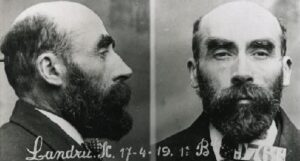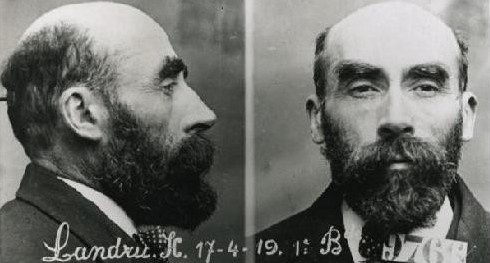Henri Landru: The French Assassin in the Classified Ads Who Shocked the World

Henri Désiré Landru, often referred to as the “Bluebeard of Gambais,” was a notorious French serial killer whose crimes in the early 20th century captivated and horrified the public.
Landru, born on April 12, 1869, in Paris, was a con artist, bigamist, and murderer who preyed on vulnerable women during and after World War I. His carefully calculated and grisly deeds made him one of the most infamous criminals in French history.
Early Life and Criminal Beginnings
Henri Landru was born into a lower-middle-class family in Paris. His father was a stoker, and his mother worked as a laundress. Despite his modest upbringing, Landru showed early signs of intelligence and ambition. He was an altar boy in his youth and received a solid education. However, after a stint in the military and several unsuccessful business ventures, Landru’s life began to take a darker turn. He married Marie-Catherine Remy in 1893, and the couple had four children. But Landru’s penchant for dishonesty soon led him into a life of crime.
Landru’s criminal career began with petty fraud and embezzlement, but he quickly escalated to more elaborate schemes. He was arrested several times for financial fraud, and by 1914, he had served time in prison. Despite these setbacks, Landru’s criminal activities only intensified. As World War I broke out, he saw an opportunity to exploit the chaos and despair around him, setting the stage for his most heinous acts.
The Modus Operandi: A Lethal Charmer
Landru’s primary targets were middle-aged, widowed, or lonely women—many of whom were left vulnerable by the loss and instability brought on by the war. He advertised in lonely hearts columns under various aliases, posing as a wealthy widower or a man of status seeking companionship. He was charming, articulate, and persuasive, traits that allowed him to gain the trust of his victims quickly.
Once he lured these women into his web, Landru’s method was coldly calculated. He would court them, gain their confidence, and then convince them to move in with him at his villa in Gambais, a rural town outside of Paris. Landru’s victims were often asked to bring their savings and personal belongings, which he promptly stole. After securing their money, he would murder them, dismember their bodies, and burn the remains in his stove to destroy any evidence.
Between 1914 and 1919, Landru is believed to have murdered at least ten women, as well as the teenage son of one of his victims. However, some estimates suggest the true number could be higher, as he was adept at covering his tracks. His meticulous record-keeping, which included a list of his victims’ names and financial transactions, would later play a crucial role in his downfall.
The Investigation and Capture
Landru’s downfall began when relatives of his victims grew suspicious of their disappearances. In particular, the sister of one of his victims, Célestine Buisson, reported her sister missing and led the police to Landru. At first, the investigation stalled due to lack of evidence, but the police persisted. They eventually traced Landru’s multiple aliases and fraudulent activities, uncovering the chilling pattern of women who had vanished after meeting him.
In April 1919, Landru was arrested at his Paris apartment. Despite his attempts to maintain his innocence, police discovered detailed records of his crimes, including the names of missing women and their belongings. Landru’s meticulous bookkeeping—a habit that had allowed him to manage his complex web of deceit—became the key evidence against him.
Trial and Execution
Landru’s trial in 1921 was a media sensation. The public was both horrified and fascinated by the suave, bearded man who calmly faced the charges against him. Dubbed the “Bluebeard of Gambais” after the folktale of Bluebeard, a murderous husband who kills his wives, Landru’s stoic demeanor in court only added to his notoriety. The trial was filled with dramatic testimonies, including tearful accounts from the families of the victims and graphic descriptions of the grisly evidence.
The prosecution built a strong case based on circumstantial evidence, given that no bodies were ever found. Landru’s defense argued that without concrete proof of murder, such as bodies or eyewitnesses, a conviction was unjust. However, the ledger of names and financial details, combined with witness accounts, painted a damning picture.
On November 30, 1921, after a sensational trial, Landru was found guilty of eleven murders and sentenced to death. Despite his adamant claims of innocence, Landru was executed by guillotine on February 25, 1922, at the age of 52.
Legacy of Horror
Henri Landru’s crimes have left an indelible mark on history, not only for their brutality but also for the way they highlighted vulnerabilities in society during wartime. His case exposed the dangers faced by lonely, vulnerable individuals seeking companionship and the ease with which a skilled manipulator could exploit societal disruptions.
Landru’s story has inspired numerous books, films, and plays, and he remains a morbid figure in the annals of criminal history. His ability to lead a double life—as a seemingly respectable gentleman and a ruthless killer—continues to captivate and terrify. The case of Henri Landru serves as a chilling reminder of how easily charm and deception can mask the darkest of intentions.
Henri Landru was not just a murderer; he was a master manipulator who used his intelligence and charm to exploit the vulnerable. His story is a haunting example of how personal tragedies and societal upheaval can be twisted by those with malevolent intent. The meticulous records he kept, which ultimately led to his capture, are a testament to his methodical nature—both as a killer and as a con artist. Landru’s legacy endures as a stark warning of the horrors that can lie behind a friendly facade.

